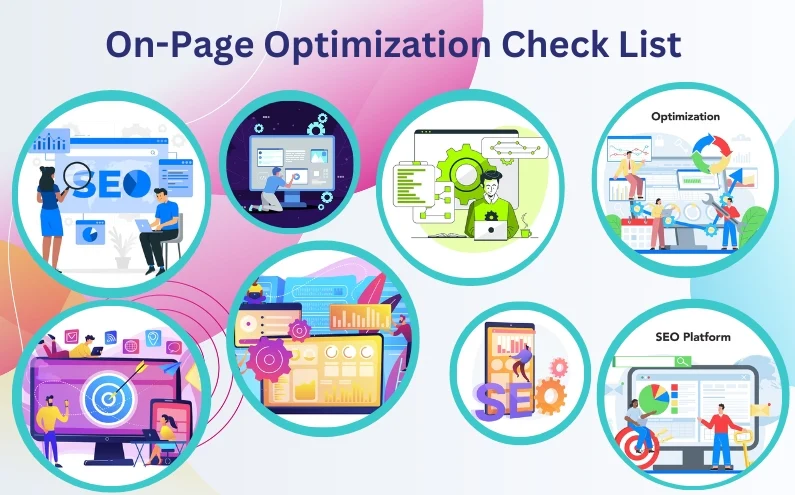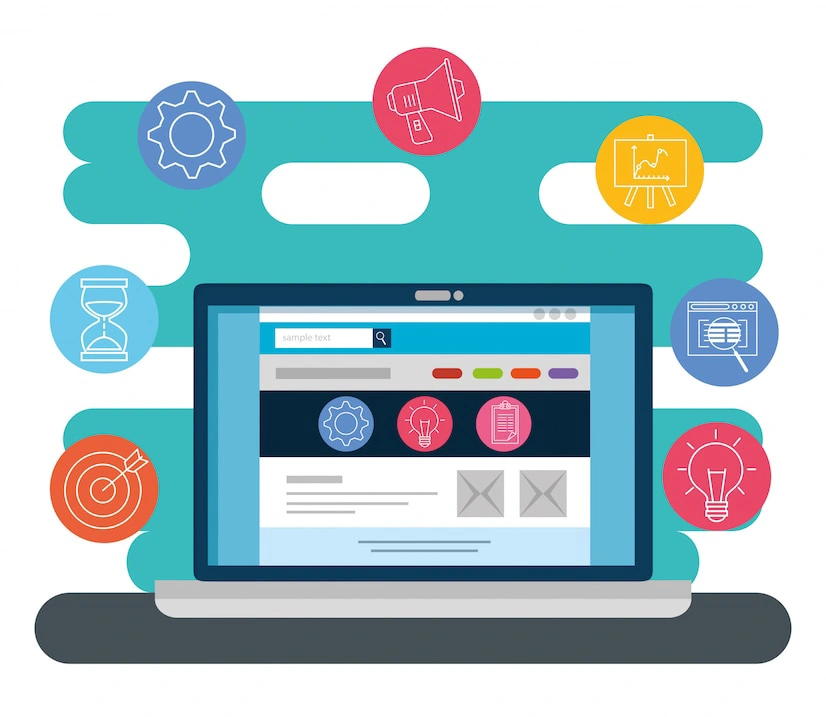What is On-page Optimization?
Before jump in to the process of implementing on-page optimization, let’s understand what exactly it is. On-page optimization, often referred to as on-page SEO, involves fine-tuning web pages to attain higher rankings on search engine results pages (SERPs) for specific targeted keywords. The term “on-page” pertains to optimizing all elements found directly on the website itself, encompassing HTML code, images, links, and other components.
Google assesses each webpage individually, considering various ranking elements. These factors encompass the presence of valuable and distinctive content, precisely targeted title tags, concise and focused URLs, well-optimized image alt text, and anchor text that strategically incorporates keywords.
Why on-page Optimization is Important?
On-page optimization is crucial for several compelling reasons:
1. Improved Search Engine Rankings
Effective on-page optimization enhances your website’s visibility on search engine results pages (SERPs). When your web pages are optimized for specific keywords, search engines are more likely to rank them higher, increasing your chances of being found by users.
2. Relevance and User Intent
By aligning your content with user search intent, on-page optimization helps you create relevant and valuable content that directly addresses the needs and queries of your target audience. This improves user satisfaction and encourages longer engagement on your site.
3. Enhanced User Experience (UX)
On-page optimization focuses on improving elements like page speed, mobile responsiveness, navigation, and overall usability. A positive user experience not only keeps visitors on your site but also encourages them to explore more pages and return in the future.
4. Increased Organic Traffic
As your website ranks higher in search results due to effective on-page optimization, you’ll naturally attract more organic (non-paid) traffic. This can lead to a steady stream of potential customers and clients discovering your products, services, or content.
5. Reduced Bounce Rates
When users find what they’re looking for quickly and easily on your website, they are less likely to “bounce” back to the search results. Well-optimized pages lead to lower bounce rates, indicating that users are finding value in your content.
6. Better Click-Through Rates (CTR)
A well-crafted title tag and meta description, which are part of on-page optimization, can make your search result snippet more enticing to users. A compelling snippet can lead to higher click-through rates, driving more traffic to your site.
7. Competitive Advantage
In a highly competitive online landscape, effective on-page optimization can give you an edge over competitors who may not be paying as much attention to these details. It allows you to stand out and showcase your expertise.
8. Optimal Content Indexing
Properly optimized HTML code and internal linking help search engines understand your content’s structure and hierarchy. This aids in better indexing and crawling of your site, ensuring that all your valuable content gets properly recognized and ranked.
9. Cost-Effectiveness
On-page optimization is a cost-effective strategy compared to paid advertising. Once your pages are optimized, the benefits continue to accrue over time without ongoing financial investment.
10. Foundation for Off-Page SEO
On-page optimization lays the groundwork for effective off-page SEO efforts. When your website’s on-page elements are optimized, external factors like backlinks and social signals have a stronger impact on your overall SEO strategy.
In essence, on-page optimization is the cornerstone of a successful SEO strategy. It not only helps search engines understand and rank your content but also creates a better experience for your users, driving organic traffic, engagement, and ultimately, conversions.
How to Do On-Page Optimization- A Step by Step Guide
On-page optimization is a crucial aspect of search engine optimization (SEO) that involves optimizing various elements on a webpage to improve its visibility and ranking in search engine results. Here’s a step-by-step guide on how to perform on-page optimizations:
1. Keyword Research
Keyword research is a fundamental aspect of search engine optimization (SEO) that involves identifying and analyzing the specific words and phrases that users enter into search engines when looking for information, products, or services. Effective keyword research helps you understand what your target audience is searching for and allows you to optimize your website’s content to match those search queries. Before you dive into optimization, conduct thorough keyword research to identify the terms your audience is searching for. Tools like Google Keyword Planner or SEMrush can help you discover high-potential keywords relevant to your content.
2. Title Tag Optimization
The title tag, a crucial on-page optimization element, plays a pivotal role in capturing both search engine attention and user interest. When executed effectively, title tag optimization can significantly enhance your website’s visibility in search engine results and entice users to click through. Keep the word limit under 60 characters.
3. Meta Tag Optimization
Meta descriptions are the unsung heroes that can greatly influence a user’s decision to click on your link in search results. Crafting an enticing and informative Meta description is a key on-page optimization strategy that can significantly enhance your website’s visibility and click-through rates.
4. Heading Tag Optimization
Headings, often represented as H1, H2, H3, and so on, are not just about styling your content—they are essential elements for both search engines and users. Proper heading optimization enhances the structure, readability, and search engine visibility of your web pages.
- H1 (Heading 1): This is the main heading for your page and should capture the primary topic or theme of the content. Use only one H1 tag per page.
- H2 (Heading 2): Use H2 tags for major sections or subtopics within your content. These headings provide a clear hierarchy and break down your content into meaningful sections.
- H3, H4, etc. (Subheadings): These tags are used to further divide content under H2 headings into smaller subsections. The hierarchy continues with H3, H4, and so on, representing decreasing levels of importance.
5. URL Structure
A well-optimized URL structure is crucial for both search engine optimization (SEO) and user experience. It helps search engines understand the content of your web pages and provides users with a clear and meaningful path to navigate your website.
6. Content Quality
Content quality is a critical factor in the success of any website or online platform. High-quality content not only engages and informs your audience but also plays a significant role in search engine optimization (SEO) and building your brand’s credibility.
7. Keyword Density
Keyword density refers to the percentage of times a specific keyword or keyphrase appears within a given block of text, usually expressed as a ratio to the total number of words in that text. While keyword density used to be a prominent factor in search engine optimization (SEO), its significance has diminished over time due to search engines’ evolving algorithms. Instead of focusing solely on keyword density, it’s more important to create high-quality, valuable content that serves the needs of your audience.
8. Image Optimization
Image optimization is the process of adding alt text, image resizing, responsive design reducing the file size of images while maintaining acceptable visual quality. This practice is essential for improving website performance, user experience, and search engine optimization (SEO).
9. Internal and External linking
Internal linking and external linking are two important strategies in search engine optimization (SEO) that contribute to better website structure, user experience, and overall online visibility.
Internal linking involves creating hyperlinks that connect different pages within the same website. These links help users navigate through your site and establish a hierarchical structure for your content.
External linking involves placing hyperlinks on your web pages that direct users to other websites. These links provide additional resources, references, and credibility to your content.
10. Mobile Responsiveness
Mobile responsiveness is a critical aspect of modern SEO. By providing a positive user experience for mobile users and aligning with Google’s mobile-first indexing approach, you can improve your search rankings, attract more organic traffic, and enhance your overall online presence. Prioritizing mobile responsiveness is a strategic investment in your website’s long-term SEO success.
11. Page Speed Optimization
Page speed is a crucial factor in search engine optimization (SEO) that directly impacts user experience, search rankings, and overall website performance. Google and other search engines consider page speed when determining how to rank and index web pages.
12. Schema Markup
Schema markup, also known as structured data markup, is a code that you can add to your website’s HTML to help search engines understand the content and context of your web pages. It provides additional information about your content, making it more easily interpretable by search engines like Google, Bing, and Yahoo. This can lead to enhanced search results, such as rich snippets, which display more detailed and relevant information to users.
13. Canonicalization
Canonicalization refers to the process of standardizing and resolving various URL variations or duplicate content issues to ensure that search engines view a single, preferred version of a web page. It’s an essential practice in search engine optimization (SEO) to prevent duplicate content problems and improve a website’s overall visibility and rankings. Canonicalization helps search engines understand which version of a page should be indexed and ranked.
14. SSL Certificate
SSL certificate is not only essential for website security and user trust but also plays a role in search engine optimization. By securing your website with HTTPS, you can positively impact search rankings, user experience, and overall online credibility, contributing to a successful and well-optimized website.
15. Webmaster Tool
Google Search Console, formerly known as Webmaster Tools, is a powerful set of tools that provides invaluable insights and data to help you optimize your website for search engines. By using Search Console effectively, you can enhance your website’s visibility, fix issues, and make informed decisions to improve your overall online presence and search rankings
16. LSI Keywords
LSI Keywords, short for Latent Semantic Indexing Keywords, are terms and phrases that are semantically related to a main keyword. These keywords are used by search engines to understand the context and meaning of a web page’s content, which helps improve the accuracy of search results and enhances the user experience. Incorporating LSI keywords in your content can also contribute to better search engine optimization (SEO).
17. Breadcrumbs
Breadcrumbs are a navigational aid used in websites to show the hierarchical path from the homepage to the current page being viewed. They provide users with a visual trail of their navigation path, helping them understand the site’s structure and easily backtrack to previous pages. Breadcrumbs also have SEO benefits by improving user experience and indicating the site’s structure to search engines.
18. Monitor and Update
Consistency is the key to success. Monitoring and updating your website are ongoing processes that contribute to its success, user satisfaction, and search engine visibility. By proactively identifying issues, optimizing content and staying current with best practices, you can ensure that your website remains competitive and effectively serves your audience’s needs.
19. User Experience
Understanding user intent is essential for delivering valuable and relevant content that meets the needs and motivations of your audience. By aligning your content strategy with user intent, you can improve search rankings, user engagement, and overall online success.
20. Geographical Targeting
Geographical targeting in SEO refers to optimizing your website and online content to target a specific geographic location. This strategy aims to improve your visibility in local search results, making it easier for potential customers in your target area to find your business. Geographical targeting in SEO is particularly valuable for businesses that have a physical presence, such as local stores, restaurants, or service providers.
Mastering the art of on-page optimization empowers you to create web content that not only captivates your audience but also gains favor with search engines. By following the steps outlined in this comprehensive guide, you’ll be equipped with the knowledge and tools necessary to enhance your website’s visibility, drive organic traffic, and provide an exceptional user experience. Remember, on-page optimization is a continuous process that requires dedication and adaptability, but the rewards in terms of search rankings and audience engagement are well worth the effort.







